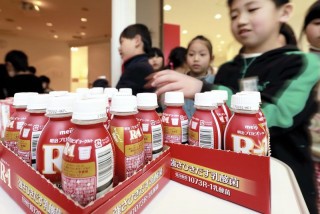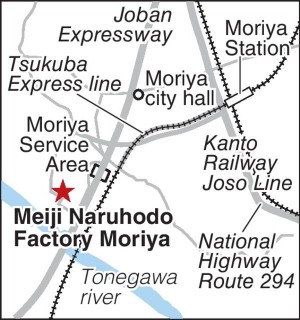Loading
Search
▼ Let’s Go to The Museum / Model Cow Offers Hands-on Milking Experience
- Category:Experience
MORIYA, Ibaraki — Meiji Co.’s Moriya Factory, which was established in 1998, churns out about 2 million packs a day of products such as Meiji Bulgaria Yogurt. Visitors can see the production process while learning about the history and attractiveness of dairy products. I visited on the day that students of Nanae Elementary School in Bando, Ibaraki Prefecture, were on a field trip to the factory.
As the children watched machines filling and sealing yogurt packs
through a glass partition, factory staff member Sumie Okaami asked them, “Do you know what is added to milk to make yogurt?”
The students replied brightly, “It’s lactic acid bacteria!”
Okaami then explained, “Lactic acid bacteria is a very good bacteria that helps keep our tummies in shape and helps keep us from catching colds.”
Yogurt, eaten since several thousand years ago, is said to have been created as a result of bacteria getting into domestic animals’ milk by chance.
At the factory, visitors can learn many things about yogurt, such as that more than 1 billion lactic acid bacteria are contained in about 100 grams of yogurt, and drinking yogurt is made not by adding water but by using a machine to crush solid yogurt.
After the factory tour, the students entered the round food education room and sat at tables. Okaami then asked the students, “Of the bones made in your body when you were a baby, how many remain?” The answer is none. Only one student answered correctly. Bones are destroyed by osteoclastic cells and new bones are created by osteoblastic cells. Bones grow by repeating this process, so the bones of a newborn baby do not remain when the baby has grown up, according to Okaami.
Having learned that bones are made from calcium, found in high quantities in milk and yogurt, the visitors then were given the hands-on experience of milking a cow using a life-size model.
“I did not know many things, including that yogurt contains a lot of lactic acid bacteria,” said a smiling Sakura Kazami, an 8-year-old girl in the second grade. “I have not eaten yogurt much, but I will eat it more from now on.”
Having learned that bones are made from calcium, found in high quantities in milk and yogurt, the visitors then were given the hands-on experience of milking a cow using a life-size model.
“I did not know many things, including that yogurt contains a lot of lactic acid bacteria,” said a smiling Sakura Kazami, an 8-year-old girl in the second grade. “I have not eaten yogurt much, but I will eat it more from now on.”
■ Meiji Naruhodo Factory Moriya
The Meiji Naruhodo Factory Moriya museum started as the Milk-kan at the same time the factory opened. In July last year, the facility was refurbished and the name was changed to the current one. The factory tour lasts from 60 to 90 minutes, including a food education workshop.
Reservations are required. The tour requires a minimum of two participants and up to 100 adults can participate on each tour.
Address: 3456 Nogisaki, Moriya, Ibaraki Prefecture
Hours: The tour is held three times a day, from 10 a.m., 1:30 p.m. and 3 p.m. The factory is closed on Sundays, national holidays, year-end and New Year’s holiday, and select other days.
Admission: Free
Inquiries: call (0297) 20-6041
- February 16, 2017
- Comment (0)
- Trackback(0)





